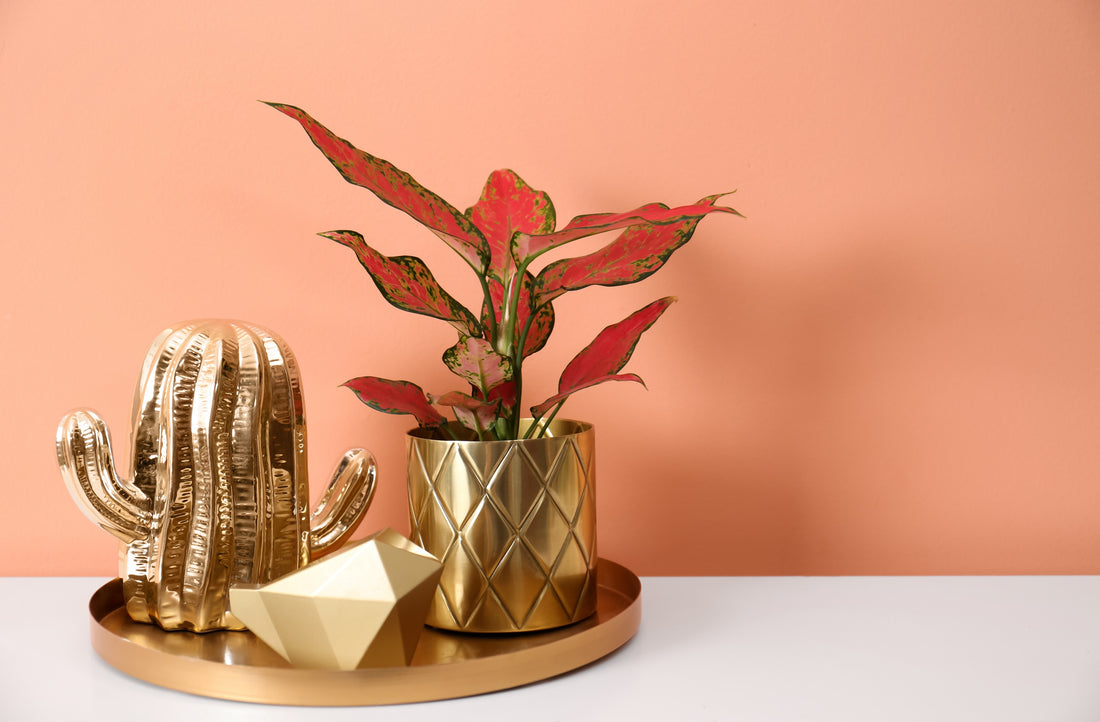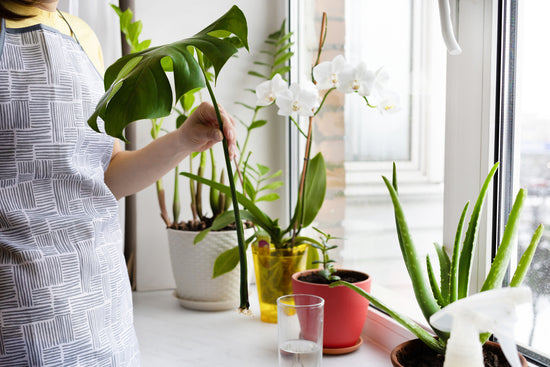Can thrive with minimal care. ✔
Needs very little water ✔
Can live happily in not so bright corners ✔
Purifies air ✔
Has vividly coloured foliage ✔
Has many varieties ✔
Can be grown in water ✔
With over 20 varieties of Aglaonema that are grown as house plants, you will be spoilt for choice. They range in colour from beautiful fresh greens to variegated silvers and stunningly rich dark pinks. Aglaonemas are a perfect fit for your bedrooms, modern living rooms, balconies, and even offices where direct light is an issue. They not only add colour and interest with their stunning variegations but live happily with even the newest of gardeners.
The Chinese Evergreen is a simple plant to care for with simple needs and will live happily in most lighting and humidity conditions in a regular home. It has just one simple rule – the lighter the variegations, the more sunlight your aglaonema/Chinese evergreen will need. All varieties of the Chinese Evergreen have large, narrow, and glossy oval leaves on short stems. Although not famous for its flowers, they sometimes do have white peace lily like blooms from spring to summer.

Common name: Chinese evergreen
Botanical name: Aglaonema commutatum
Sunlight: Partial shade to Low light
Air: Well ventilated
Soil: Rich and well-draining
Water: When the top two inches of the soil is dry.
Fertilisers: Once every 3 weeks.
Issues: Rot due to overwatering. It does better with underwatering.
Sunlight
By nature, Aglaonemas show the best growth in well-lit locations such as an east or north facing windowsill. Bright, but indirect sunlight is optimal but it can live happily in low-light areas too, although the growth will slow down considerably. Make sure to not place your aglaonemas in full sun as it will lead to lea burn.
PS: As mentioned above, the lighter the variegations on your Aglaonema, brighter the light it will need.

Placement
The Aglaonema will do great in almost any corner of your home, from your shaded patios to your dimly lit bedrooms. If your aglaonema is smaller, place it on tabletops, shelves, or windowsills. The larger plants look good any in pedestal planters or floor planters. Their interestingly coloured foliage and ability to live in low-light areas make them a great fit for corners that have nothing much going on for them. Even if you are placing your Chinese evergreen in low light corners, sunning it weekly for a couple of hours gives them enough fuel to stay healthy and keep you happy.

Watering
Aglaonemas can live happily in both dry and moist conditions – but they hate being overwatered. The thick stems store water for emergency so make sure that while your aglaonema is watered regularly, you don’t overwater it, let the soil dry out in between watering. The plant does better with underwatering than overwatering, but don’t keep it dry for too long. Water your Aglaonema thoroughly till water comes out of the drainage hole and always empty the base plate. The watering requirement will change with the availability of light; more light means more water.
Fertilisers
Feed your Aglaonema with a generic houseplant fertiliser every three to four weeks, diluted as instructed on the packaging. Make sure the fertilisers have the three major nutrients, nitrogen, phosphorous, and potassium. Ugaoo’s Plan-T-onic and NPK are great options for both root and foliar applications. Another great way to add nutrition to the soil is through monthly addition of vermicompost or any other organic compost.
Propagation
Chinese Evergreens can be propagated by stem cutting and by dividing the plants. The plant grows pups around the mother plant that can be successfully separated once they are of a good size. The best season to propagate this plant is during summer when the weather is the warmest – aglaonemas favourite weather.

Potting and Repotting Aglaonema
Aglaonemas are slow growers and love to be root bound so repotting will not be a regular job. While repotting make sure to use a rich but well-draining medium and not select a plant much bigger than the current one. It is a soft stemmed plant so loosen the soil carefully without damaging the plant.
Plant problems
While not really susceptible to pests or diseases, the Chinese evergreen can sometimes get infected with scale, mealybugs, or spider mites due to infected plants around it. All these issues can be treated with an insecticide or neem oil.
Typically, its most common issues arises due to too much moisture that leads to root rot and fungal problems.
Some other issues with eh Chinese evergreen is
Aging: Time causes yellowing of older leaves and its just the lifecycle. Just remove the affected leaf.
Too much light: Direct sunlight causes leaf burn. Prune the burned leaves and move it out of direct light.
Cold drafts: The plant prefers warm, draft-free areas.
Underwatering: A long dry spell will dry out the leaves. Water the plants regularly and keep it in a well-lit spot to help recover.
Overwatering: Aglaonemas prefer being underwatered than overwatered. Let the top two inches of the soil dry before watering to prevent root rot.

Happy Gardening!!










